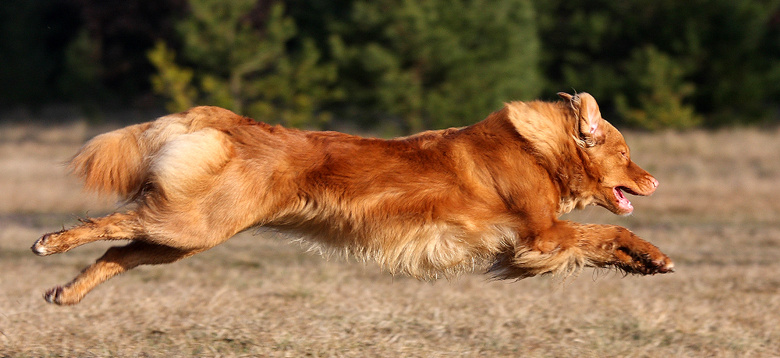Health
Nova Scotia Duck Tolling Retrievers are generally robust and healthy dogs that are not prone to sickness and enjoy and demand hours of excursions and training, even in windy weather.
At the end of 2010, the breed was negatively reported in the media – the reason was a newly founded, extremely small German Toller club, which had taken it upon itself to want to cross other breeds into the Toller population. To get this approved, an unprecedented „character assassination campaign“ began concerning the health of the Toller. DRC Toller breeders were suddenly confronted with the accusation of „animal cruelty“ or „torture breeding“. The efforts of the said Tollerclub remained fortunately unsuccessful – and meanwhile the club also does not exist any more. A rogue, who thinks evil thereby.
The at that time written statement of the DRC Toller breeders to the health situation of the breed is however still current in its basic pillars and for Toller interested in any case worth reading, therefore it is still to be found here on our side:
Toller breeding statement (PDF, 82 KB)
Diseases
The following diseases occur basically rarely, nevertheless, every Toller owner should know them to be able to react quickly in case of corresponding symptoms:
Autoimmune disease
This disease unfortunately occurs much more frequently in the Toller than in other breeds – nevertheless, diseased dogs are isolated cases. Although SRMA is little researched so far, there seems to be a hereditary disposition. There is an inflammation of the meninges and sometimes also of the joints, which reacts to cortisone with spontaneous improvement. This disease occurs mainly in young Tollers within the first two years of life and manifests itself by high fever and a rigid head and neck posture with apparently great pain. The dog does not like to be touched and appears apathetic. With these symptoms all alarm bells should immediately ring in every Toller owner – the dog belongs immediately into expert hands!
Autoimmune disease
This disease is more common in middle-aged Tollers and results in severe inflammation of the joints. The diseased dog is in great pain and lame. Diagnosis is possible only by means of puncture of the diseased joints.
Retinal loss
PRA is a progressive atrophy of the retina, which sooner or later leads to blindness in affected dogs. However, there is now a genetic test for PRA, so that it is possible for breeders to exclude the later disease of their puppies by selecting suitable mating partners.
Genetic mutation
CEA affects the development of the retina, which can have various manifestations. As with PRA, it is now possible to have your dog tested for CEA, so the disease does not play a major role in Toller..
Malformations of the joints
HD/ED affects Tollers rather rarely compared to others, especially the larger breeds. These deformities of the hip and elbow joints have a hereditary component and lead to premature wear of the joints, which is painful for the dog. To prevent HD/ED, especially in the first year of life, you should make sure that your Toller is nice and slim and that he jumps or runs stairs as little as possible. From the age of 12 months you should have your dog x-rayed to find out the degree of HD/ED of your dog.
Shortened limbs
This disease, which is very likely to be inherited, is manifested by shortened forelimbs and hindlimbs and a crippled forehand („dachshund legs“). The entire dog looks disproportionate: a long back and very short, misshapen legs. Despite the often typical appearance, CHO can only be diagnosed without doubt by means of an X-ray examination.

Litter Planning
No litter is planned in our kennel for an indefinite period of time. We are therefore not accepting any puppy inquiries.







